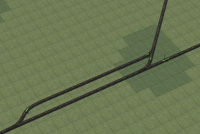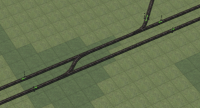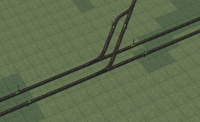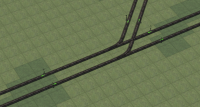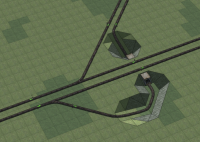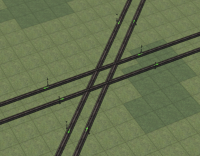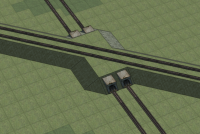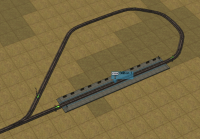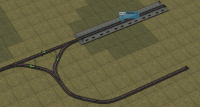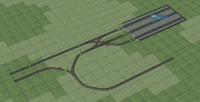Difference between revisions of "Junctions"
(→Terminus Junctions) |
|||
| Line 5: | Line 5: | ||
All the exaples below have the basic signaling shown on the images, better signalling positions can improve their preformance. | All the exaples below have the basic signaling shown on the images, better signalling positions can improve their preformance. | ||
| − | ==Y Junctions== | + | ==Y-Junctions== |
Y-Junctions act as a convergence or divergence points between two routes on a railway line. Simple solutions work well, but tend to have significant drawbacks when used at high capacity. | Y-Junctions act as a convergence or divergence points between two routes on a railway line. Simple solutions work well, but tend to have significant drawbacks when used at high capacity. | ||
| Line 60: | Line 60: | ||
|} | |} | ||
| − | ==Crossings== | + | |
| + | ==X-Crossings== | ||
These are for locations on the tracks where two lines must cross over each other, with no tracked connection between the two. | These are for locations on the tracks where two lines must cross over each other, with no tracked connection between the two. | ||
| Line 93: | Line 94: | ||
| 0 | | 0 | ||
|} | |} | ||
| + | |||
| + | |||
| + | ==X-Junctions== | ||
| + | These are for locations on the tracks where lines cross over and trains can switch between both lines. These junctions are usually complex to build and take a lot of space. | ||
| + | |||
| + | {| class="wikitable" | ||
| + | ! Image | ||
| + | ! Name | ||
| + | ! Information | ||
| + | ! Signalling Complexity | ||
| + | ! No. of Points | ||
| + | ! No. of Crossings | ||
| + | |- | ||
| + | | [[File:Junction_Clover.png|200px]] | ||
| + | | Clover Leaf Interchange | ||
| + | | A Line that allows a continuous flow of trains over it. Trains can exit the junction in all 4 directions. This junction takes up a lot of space, reducing its feasibility to large flat maps with long distances between train destinations. | ||
| + | | Med | ||
| + | | 16 | ||
| + | | 0 | ||
| + | |- | ||
| + | | [[File:Junction_Jewel.png|200px]] | ||
| + | | Jewel | ||
| + | | A continuous flow junction, which allows trains to exit in all 4 directions. This junction is more compact than the Clover Leaf, however it incorporates more gradients and curves which limits train speeds through the junction. | ||
| + | | Low | ||
| + | | 8 | ||
| + | | 0 | ||
| + | |- | ||
| + | | [[File:Junction_Diamond.png|200px]] | ||
| + | | Diamond Crossing | ||
| + | | This junction is useful for placing in stations at the end of the line. This junction can be combined with the [[Junctions#Term|Main Terminus]] to prevent train blockages when operating with more trains than the number of available platforms. | ||
| + | | High | ||
| + | | 4 | ||
| + | | 1 | ||
| + | |} | ||
| + | |||
==Terminus Junctions== | ==Terminus Junctions== | ||
| Line 132: | Line 168: | ||
|- | |- | ||
| [[File:Junction_Turminums.png|200px]] | | [[File:Junction_Turminums.png|200px]] | ||
| − | | Main Terminus | + | | <span id="Term"></span>Main Terminus |
| A high capacity railway station that works with a continuous supply of trains. There are no reversing facilities, therefore best used when reversing trains are disabled. Further signalling and platforms can be added to increase the capacity of the Station beyond a 3-train limit. | | A high capacity railway station that works with a continuous supply of trains. There are no reversing facilities, therefore best used when reversing trains are disabled. Further signalling and platforms can be added to increase the capacity of the Station beyond a 3-train limit. | ||
| Medium | | Medium | ||
Revision as of 16:45, 3 November 2017
Game Manual
- Basics
- Game content
- Infrastructure
 Railways
Railways
- Signals
- Junctions
 Roadways
Roadways Airports
Airports Landscaping
Landscaping Electrification
Electrification
- Vehicles
This section contains a selection of basic junctions that can be used in a railway network in Mashinky. These junctions vary in complexity and utility. The intention of this is to provide fundamental ideas, which can be built upon to create more complex track configurations with higher train capacity.
All the exaples below have the basic signaling shown on the images, better signalling positions can improve their preformance.
Y-Junctions
Y-Junctions act as a convergence or divergence points between two routes on a railway line. Simple solutions work well, but tend to have significant drawbacks when used at high capacity.
X-Crossings
These are for locations on the tracks where two lines must cross over each other, with no tracked connection between the two.
X-Junctions
These are for locations on the tracks where lines cross over and trains can switch between both lines. These junctions are usually complex to build and take a lot of space.
| Image | Name | Information | Signalling Complexity | No. of Points | No. of Crossings |
|---|---|---|---|---|---|
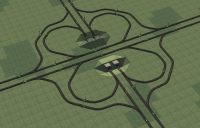
|
Clover Leaf Interchange | A Line that allows a continuous flow of trains over it. Trains can exit the junction in all 4 directions. This junction takes up a lot of space, reducing its feasibility to large flat maps with long distances between train destinations. | Med | 16 | 0 |

|
Jewel | A continuous flow junction, which allows trains to exit in all 4 directions. This junction is more compact than the Clover Leaf, however it incorporates more gradients and curves which limits train speeds through the junction. | Low | 8 | 0 |

|
Diamond Crossing | This junction is useful for placing in stations at the end of the line. This junction can be combined with the Main Terminus to prevent train blockages when operating with more trains than the number of available platforms. | High | 4 | 1 |
Terminus Junctions
These are a selection of junctions that go at the end of a railway line, these are designed for both high capacity and the ability to turn the trains around to prevent the locomotives from reversing on their return journey. The max number of trains refers the number of trains can use the station without a risk of causing a blockage. All stations below can have their capacity increased by placing block signals.

